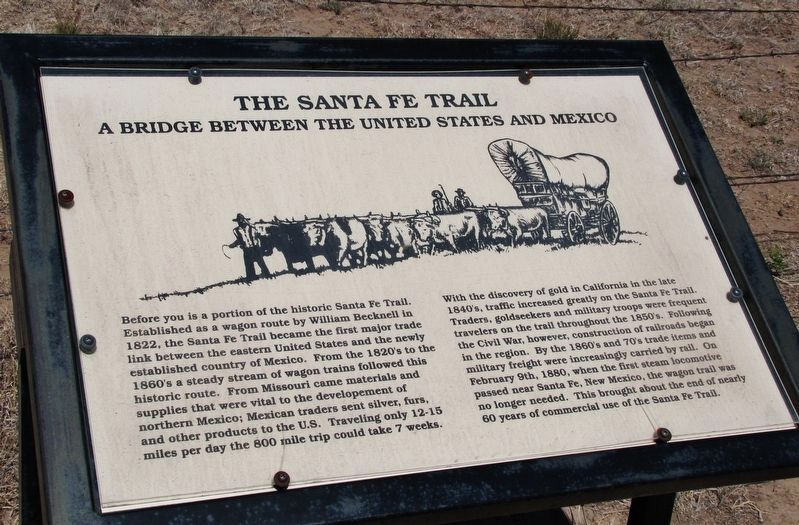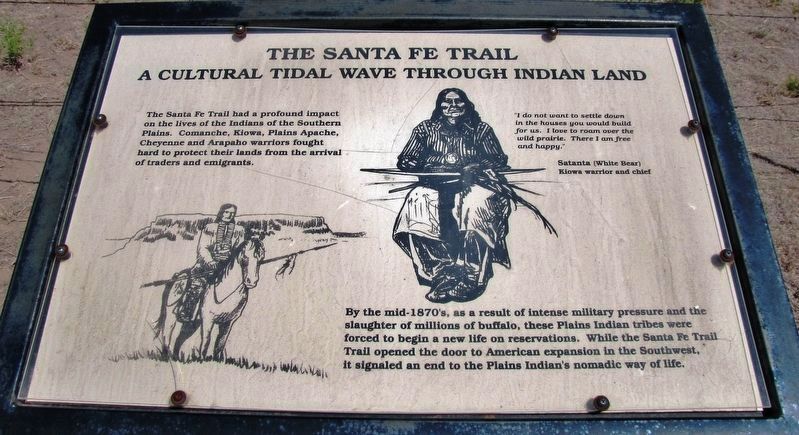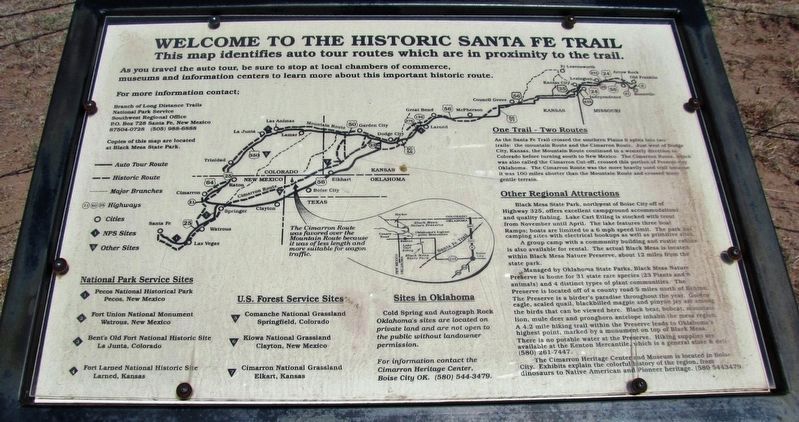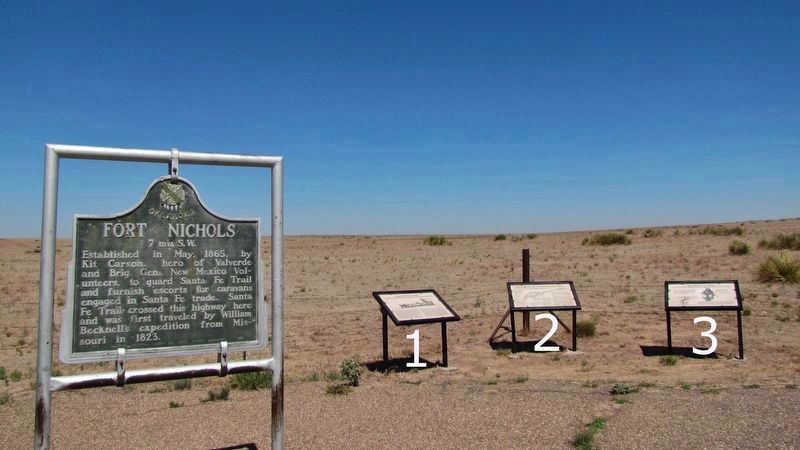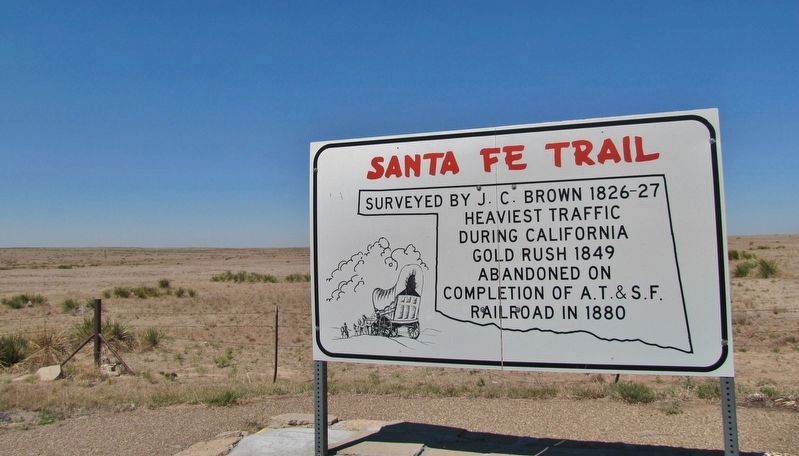Near Wheeless in Cimarron County, Oklahoma — The American South (West South Central)
The Santa Fe Trail
Inscription.
(left panel)
A Bridge Between the United States and Mexico
Before you is a portion of the historic Santa Fe Trail. Established as a wagon route by William Becknell in 1822, the Santa Fe Trail became the first major trade link between the eastern United States and the newly established country of Mexico. From the 1820ís to the 1860ís a steady stream of wagon trains followed this historic route. From Missouri came materials and supplies that were vital to the development of northern Mexico; Mexican traders sent silvers, furs, and other products to the U.S. Traveling only 12-15 miles per day the 800 mile trip could take 7 weeks.
With the discovery of gold in California in the late 1840ís, traffic increased greatly on the Santa Fe Trail. Traders, goldseekers and military troops were frequent travelers on the trail throughout the 1850ís. Following the Civil War, however, construction of railroads began in the region. By the 1860ís and 70ís trade items and military freights were increasingly carried by rail. On February 9th, 1880, when the first steam locomotive passed near Santa Fe, New Mexico, the wagon trail was no longer needed. This brought about the end of nearly 60 years of commercial use of the Santa Fe Trail.
(right panel)
A Cultural Tidal Wave Through Indian Land
"I do not want to settle down in the houses you would build for us. I love to roam over the wild prairie. There I am free and happy."
Satanta (White Bear), Kiowa warrior and chief
The Santa Fe Trail had a profound impact on the lives of the Indians of the Southern Plains. Comanche, Kiowa, Plains Apache, Cheyenne and Arapaho warriors fought hard to protect their lands from the arrival of traders and emigrants.
By the mid-1870ís, as a result of intense military pressure and the slaughter of millions of buffalo, these Plains Indian tribes were forced to begin a new life on reservations. While the Santa Fe Trail opened the door to American expansion in the Southwest, it signaled an end to the Plains Indianís nomadic way of life.
(center panel)
Welcome to the Historic Santa Fe Trail
This map identifies auto tour routes which are in proximity to the trail.
As you travel the auto tour, be sure to stop at local chambers of commerce, museums and information centers to learn more about this important historic route.
One Trail - Two Routes
As the Santa Fe Trail crossed the southern Plains it splits into two trails: the mountain Route and the Cimarron Route. Just west of Dodge City, Kansas, the Mountain Route continued in a westerly direction to Colorado before turning south to New Mexico. The Cimarron Route,
which was also called the Cimarron Cut-off, crossed this portion of Present-day Oklahoma. The Cimarron Route was the more heavily used trail because it was 100 miles shorter than the Mountain Route and crossed more gentle terrain.
Other Regional Attractions
Black Mesa State Park, northwest of Boise City off of Highway 325, offers excellent campground accommodations and quality fishing. Lake Carl Etling is stocked with trout from November until April. The lake features three boat Ramps; boats are limited to a 6 mph speed limit. The park has camping sites with electrical hookups as well as primitive sites.
A group camp with a community building and rustic cabins are also available for rental. The actual Black Mesa is located within Black Mesa Nature Preserve, about 12 miles from the state park.
Managed by Oklahoma State Parks, Black Mesa Nature Preserve is home for 31 state rare species (23 Plants and 8 animals) and 4 distinct types of plant communities. The Preserve is located off of a county road 5 miles north of Kenton. The Preserve is a birder's paradise throughout the year. Golden eagle, scaled quail, blackbilled magpie and pinyon jay are among the birds that can be viewed here. Black bear, bobcat, mountain lion, mule deer and pronghorn antelope inhabit the mesa region. A 4.2 mile hiking trail within the Preserve leads to Oklahoma's
highest point, marked by a monument on top of Black Mesa. There is no potable water at the Preserve. Hiking supplies are available at the Kenton Mercantile, which is a general store & deli. (580-261-7447)
The Cimarron Heritage Center and Museum is located in Boise City. Exhibits explain the colorful history of the region, from dinosaurs to Native American and pioneer heritage. (580-544-3479)
Topics and series. This historical marker is listed in these topic lists: Industry & Commerce • Native Americans • Roads & Vehicles • Settlements & Settlers. In addition, it is included in the Santa Fe Trail series list. A significant historical year for this entry is 1822.
Location. 36° 47.204′ N, 102° 48.319′ W. Marker is near Wheeless, Oklahoma, in Cimarron County. Marker is on 325, 3.6 miles north of E0190 Road, on the left when traveling north. Marker is located in a pull-out on the west side of the highway, at the point where the Santa Fe Trail crossed here from east to west. Touch for map. Marker is in this post office area: Boise City OK 73933, United States of America. Touch for directions.
Other nearby markers. At least 2 other markers are within walking distance of this marker. A different marker also named Santa Fe Trail (a few steps from this marker); Fort Nichols (a few steps from this marker).
More about this marker. This
marker consists of a set of three related adjacent panels.
Also see . . . The Santa Fe Trail (Wikipedia). The Santa Fe Trail was a 19th-century transportation route through central North America that connected Independence, Missouri with Santa Fe, New Mexico. Pioneered in 1821 by William Becknell, it served as a vital commercial highway until the introduction of the railroad to Santa Fe in 1880. Santa Fe was near the end of the El Camino Real de Tierra Adentro, which carried trade from Mexico City. (Submitted on March 22, 2019, by Cosmos Mariner of Cape Canaveral, Florida.)
Credits. This page was last revised on March 22, 2019. It was originally submitted on March 22, 2019, by Cosmos Mariner of Cape Canaveral, Florida. This page has been viewed 364 times since then and 27 times this year. Photos: 1, 2, 3, 4, 5. submitted on March 22, 2019, by Cosmos Mariner of Cape Canaveral, Florida.
